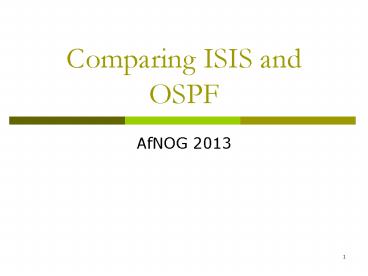Comparing ISIS and OSPF - PowerPoint PPT Presentation
Title:
Comparing ISIS and OSPF
Description:
... revision was in 1998 with RFC 2328 to fix minor problems All above OSPF RFCs authored by John Moy RFC2740 introduced OSPFv3 (for IPv6) in 1999, ... – PowerPoint PPT presentation
Number of Views:87
Avg rating:3.0/5.0
Title: Comparing ISIS and OSPF
1
Comparing ISIS and OSPF
- AfNOG 2013
2
Comparing ISIS and OSPF
- Both are Link State Routing Protocols using the
Dijkstra SPF Algorithm - So whats the difference then?
- And why do ISP engineers end up arguing so much
about which is superior?
3
What Is IS-IS ?
- Intermediate System to Intermediate System
- An IS is ISO terminology for a router
- IS-IS was originally designed for use as a
dynamic routing protocol for ISO CLNP, defined in
the ISO 10589 standard - Later adapted to carry IP prefixes in addition to
CLNP (known as Integrated or Dual IS-IS) as
described in RFC 1195 - Predominantly used in ISP environment
4
IS-IS Timeline
- 1978ish New Arpanet Algorithm
- Eric Rosen et al
- 1986 to 90 Decnet Phase V
- Radia Perlman, Mike Shand
- 1987 ISO 10589 (IS-IS)
- Dave Oran
- 1990 RFC 1195 (Integrated IS-IS)
- Ross Callon, Chris Gunner
- 1990 to present All sorts of enhancements
- Everyone contributed!
- 2008 RFC5308 adds IPv6 support
- And RFC5120 adds Multi-Topology Routing support
5
What Is OSPF ?
- Open Shortest Path First
- Link State Protocol using the Shortest Path First
algorithm (Dijkstra) to calculate loop-free
routes - Used purely within the TCP/IP environment
- Designed to respond quickly to topology changes
but using minimal protocol traffic - Used in both Enterprise and ISP Environment
6
OSPF Timeline
- Development began in 1987 by IETF
- OSPFv1 published in 1989 with RFC 1131
- OSPFv2 published in 1991 with RFC 1247
- Further enhancements to OSPFv2 in 1994 with RFC
1583 and in 1997 with RFC 2178 - Last revision was in 1998 with RFC 2328 to fix
minor problems - All above OSPF RFCs authored by John Moy
- RFC2740 introduced OSPFv3 (for IPv6) in 1999,
replaced by RFC5340 in 2008
7
IS-IS OSPF Similarities
- Both are Interior Gateway Protocols (IGP)
- They distribute routing information between
routers belonging to a single Autonomous System
(AS) - With support for
- Classless Inter-Domain Routing (CIDR)
- Variable Subnet Length Masking (VLSM)
- Authentication
- Multi-path
- IP unnumbered links
8
IS-IS and OSPF Terminology
- OSPF
- Host
- Router
- Link
- Packet
- Designated router (DR)
- Backup DR (BDR)
- Link-State Advertisement (LSA)
- Hello packet
- Database Description (DBD)
- ISIS
- End System (ES)
- Intermediate System (IS)
- Circuit
- Protocol Data Unit (PDU)
- Designated IS (DIS)
- N/A (no BDIS is used)
- Link-State PDU (LSP)
- IIH PDU
- Complete sequence number PDU (CSNP)
9
IS-IS and OSPF Terminology (Cont.)
- OSPF
- Area
- Non-backbone area
- Backbone area
- Area Border Router (ABR)
- Autonomous System Boundary Router (ASBR)
- ISIS
- Sub domain (area)
- Level-1 area
- Level-2 Sub domain (backbone)
- L1L2 router
- Any IS
10
Transport
- OSPF uses IP Protocol 89 as transport
- IS-IS is directly encapsulated in Layer 2
11
For Service Providers
- Which IGP should an ISP choose?
- Both OSPF and ISIS use Dijkstra SPF algorithm
- Exhibit same convergence properties
- ISIS less widely implemented on router platforms
- ISIS runs on data link layer, OSPF runs on IP
layer
12
For Service Providers
- Biggest ISPs tend to use ISIS why?
- In early 90s, Cisco implementation of ISIS was
much more solid than OSPF implementation ISPs
naturally preferred ISIS - Main ISIS implementations more tuneable than
equivalent OSPF implementations because biggest
ISPs using ISIS put more pressure on Cisco to
implement knobs
13
For Service Providers
- Moving forward a decade
- Early Cisco OSPF implementation substantially
rewritten - Now competitive with ISIS in features and
performance - Router vendors wishing a slice of the core market
need an ISIS implementation as solid and as
flexible as that from Cisco - Those with ISIS OSPF support tend to ensure
they exhibit performance and feature parity
14
How to choose an IGP?
- OSPF
- Rigid area design all networks must have area 0
core, with sub-areas distributed around - Suits ISPs with central high speed core network
linking regional PoPs - Teaches good routing protocol design practices
15
How to choose an IGP?
- ISIS
- Relaxed two level design L2 routers must be
linked through the backbone - Suits ISPs with stringy networks, diverse
infrastructure, etc, not fitting central core
model of OSPF - More flexible than OSPF, but easier to make
mistakes too
16
Other considerations
- ISIS runs on link layer
- Not possible to attack the IGP using IP as with
OSPF - ISISs NSAP addressing scheme avoids dependencies
on IP as with OSPF - Because biggest ISPs use ISIS, major router
vendors tend to apply new optimisation features
before they are added to OSPF
17
Comparing ISIS and OSPF
- AfNOG 2013






























